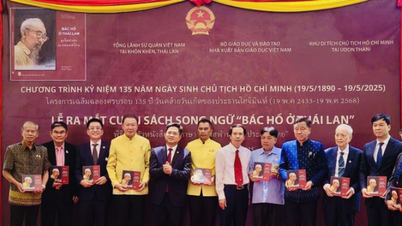If you memorize, you will not be able to solve math problems.
Mr. Tran Tuan Anh, a Math teacher at Thu Duc High School, assessed that the Math exam for grade 10 in Ho Chi Minh City is often difficult and highly classified. This is understandable because the goal of the exam is to select students for public high schools, with different quality. The exam has about 30-40% of application and high-level application questions, which are difficult for average and weak students to answer, leading to low scores.

On the other hand, with the old curriculum, students mainly practiced problem-solving skills, transformation skills, and calculation tips to get the fastest results. Meanwhile, with the 2018 curriculum, the trend has changed. The requirement of the new curriculum is to develop practical thinking, connect mathematics with life, and help students see the value of mathematics - solving practical problems.
While there is still a "memorized" learning style, learning how to solve problems by heart, the exam requires understanding the nature and application, so many students are confused and cannot solve them.
Students will fail if they are weak in skills, practice too early, and ignore the foundation.
Mr. Tuan Anh said that one of the current problems is that candidates are weak in reading and understanding mathematical models. With practical problems, problem solving, and situations, the first requirement for students is to understand the problem, know how to use mathematical language to express real-life situations, and then use mathematical tools to solve the problem.
Teacher Tuan Anh is concerned that practicing advanced exam questions too early, ignoring the foundation, not understanding the theory makes a part of students who are not solid in knowledge from grades 6 to 8 weaker in basic knowledge and skills such as: Transforming expressions, analyzing polynomials, solving equations, properties of common triangles, quadrilaterals, similar triangles... Students may also review incompletely, focus too much on a few topics they like, ignoring other important topics.
On the other hand, not having a test-taking strategy, such as doing the test in order from the first question to the last, thinking too long about a difficult question, ignoring other possible questions... also makes the test score not reflect the true ability. Therefore, according to the teacher, knowing how to allocate time when taking the test is very important. The basic principle is to do from easy questions (questions that you can probably do correctly) to difficult questions (questions that you have not thought of a solution for), you should not stop at one question for too long.
Teacher Tuan Anh also pointed out that students are often not used to the pressure of exams and are mentally weak. Many students do very well when practicing at home, but when they enter the exam room, they lose their composure, forget their knowledge, and make mistakes in simple problems. "With Math, just losing concentration for a few minutes or making a small mistake can cause the whole problem to lose a lot of points," said this teacher.
In addition, in-class tests are often short and easy, not as difficult as entrance exams. Therefore, if students do not solve test questions similar to mock tests (resolving test questions from previous years), they will easily be "overwhelmed" when taking the real test. In addition to the loss of mentality from the moment they approach the test, they will have a hard time doing the test in the exam room.
Mr. Tuan Anh advised that having access to and solving exam questions similar to the real exam questions during the exam preparation process brings many advantages. First, getting familiar with the structure of the real exam helps students understand how many questions the exam has, how many points each part is worth, how much time is spent on the test, thereby practicing the skills of allocating time reasonably when doing the test, understanding the typical types of questions on the exam, and orienting the review to meet practical requirements.
During the transition period, there will be a certain amount of variance.
Mr. Tuan Anh said that theeducation program is in the process of transitioning from old to new, so there is a certain gap between the learning content and the form of the entrance exam for grade 10, causing students to encounter difficulties and low test results, especially in Math. In addition to understanding knowledge and solving exercises to practice calculation skills, students must also know how to proactively connect to reality. Teachers, from teaching pure math knowledge, now need to add orientation to develop problem-solving and mathematical modeling skills, connecting knowledge to reality.

In the process of converting the educational program, the system of documents and teaching and learning experiences of teachers and students is not enough. The learning and teaching methods also need time to change to suit the new requirements of the new educational program.
Teacher Tuan Anh supports the 10th grade entrance exam style of Ho Chi Minh City because of the importance of this entrance exam, avoiding selecting students who memorize, passively study Math, and do not know how to use Math to handle life situations...
"The goal of the exam is to select students who truly understand math, not just because they memorized the lesson, but because it is an analytical and creative process of thinking, demonstrating intelligence," the teacher said.
Looking back at the math test scores of previous years, Mr. Tuan Anh said that the fact that nearly 50% of the tests had scores below 5 is an indication to review students' learning methods, improve and change teachers' teaching methods, so that learning math brings real value and more and more good students will become experts who can bring solutions to social problems.
“To get good statistics, we just need to make the questions more familiar and easier, but that means lowering the admission requirements, leading to top schools having difficulty recruiting good students. Therefore, the fact that 50% of students have test scores below 5 needs to be viewed positively, avoiding the sentiment that those who get that score are poor students,” said Mr. Tuan Anh.
Source: https://vietnamnet.vn/thi-lop-10-nam-2025-chuong-trinh-moi-tphcm-co-pha-dop-45-000-diem-toan-duoi-5-2400734.html



![[Photo] President Luong Cuong presents the 40-year Party membership badge to Chief of the Office of the President Le Khanh Hai](https://vphoto.vietnam.vn/thumb/1200x675/vietnam/resource/IMAGE/2025/5/19/a22bc55dd7bf4a2ab7e3958d32282c15)
![[Photo] Prime Minister Pham Minh Chinh inspects the progress of the National Exhibition and Fair Center project](https://vphoto.vietnam.vn/thumb/1200x675/vietnam/resource/IMAGE/2025/5/19/35189ac8807140d897ad2b7d2583fbae)
![[Photo] General Secretary To Lam attends the conference to review 10 years of implementing Directive No. 05 of the Politburo and evaluate the results of implementing Regulation No. 09 of the Central Public Security Party Committee.](https://vphoto.vietnam.vn/thumb/1200x675/vietnam/resource/IMAGE/2025/5/19/2f44458c655a4403acd7929dbbfa5039)














































































![[VIDEO] - Enhancing the value of Quang Nam OCOP products through trade connections](https://vphoto.vietnam.vn/thumb/402x226/vietnam/resource/IMAGE/2025/5/17/5be5b5fff1f14914986fad159097a677)







Comment (0)